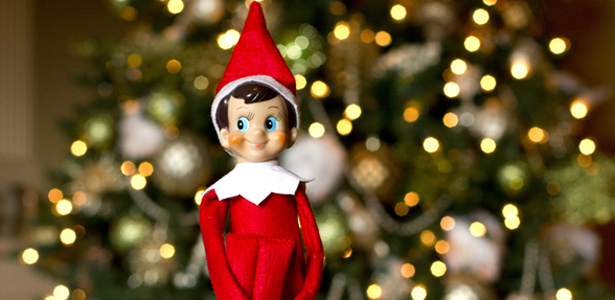
just chilling. no, literally. that thing is chilling.
He sees you when you’re sleeping, he knows when you’re awake, he knows if you’ve been bad or good, so be good for goodness sake. Santa is already an imposing omnipotent figure meant to shame kids into playing by the rules to score presents, but to really keep kids on their best behavior at Christmastime (never mind the rest of the year), some parents also employ a sort of surrogate to visually remind children of Santa’s possible scorn. Enter Elf on a Shelf.
For the uninitiated, the Chicago Tribune sums up the naughty nightly practice nicely, “An estimated 6 million copies of the book and its accompanying red elf toy have sold since it was released in 2005. Parents ask their children to name the elf, then help the doll “magically” appear in a new spot each morning, and often share elaborate hiding spot ideas on Facebook and Pinterest. A parody, “The Elf off the Shelf,” and “inappropriate elf” images on Google and YouTube also have fueled its popularity.”
The Elf on the Shelf story was penned with the best of intentions by Carol Aebersold, a retired music teacher whose adult daughter suggested the family tradition as a story the empty-nester could write to keep busy. Aebersold is proud of the story’s success and impressed with parents’ devotion to the month-long practice.”It blows my mind, but I feel so good knowing that I am actually leaving a legacy for my grandchildren,” she said. “And I am in awe of the creativity of some of these moms and dads who have come up with the things for the elf to do.” Finding the cute elf caught mid mischief-making each morning and parents taking joy in providing it are a fun tradition, but critics point out that more often than not parents are actually using the little guy to lord over their kids with threats of what their impish friend will report to Santa Claus.
“I don’t think that’s a very good strategy,” Margret Nickels, clinical psychologist and director of the Erikson Institute Center for Children and Families in Chicago, told the Tribune. “It’s the parents who want to be in charge as the authority in the house. Not the elf or Santa Claus.”
“It is so much better for the parents to be the disciplinarian rather than have this elf impose an atmosphere of being watched,” she said. “To me, the risk of the elf is that parents think that this is a legitimate, healthy way to teach discipline to their children, which it is not.”
Then consider the creep factor. This sort of modern mythology allows yet another fictional character into our homes but unlike characters with some brevity to their “appearances,” like Santa, the Easter Bunny, or the Tooth Fairy, Elf on the Shelf is a month-long presence meant to watch over every move and tattle up in the North Pole when protocol is broken. Kids are flexible in what they’ll buy into, but child psychiatrist Janice Kowalski noted that children can find this just as unsettling as adults. She said that some children could be “spooked by the idea of an elf watching them,” which was her experience with the toy at first. “You definitely just have to be aware that they might get anxious about thinking somebody’s in the house. If that happens, you maybe don’t want to use the toy.”
Be honest. Is The Elf on the Shelf a fear-mongering technique to keep your kids in line, or a fun tradition the family looks forward to each day in December? — Casandra Armour



-300x169.jpg)












